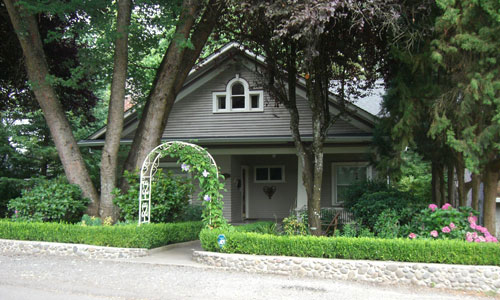First Addition: Lake Oswego, Oregon

Summary
The First Addition Neighborhood of Lake Oswego, Oregon, has what many communities seek: a small-town atmosphere, services and shopping within walking distance, and residents' commitment to a set of common priorities.
The American Planning Association has selected the First Addition neighborhood as one of 10 Great Neighborhoods in America for its dedication to community values and priorities, to both capitalize on the values of the past and plan to ensure quality of life for the community into the future.

A kiosk announcing concerts in nearby Millennium Park. This is a park that is enjoyed by Lake Oswego Citizens and First Addition Residents. Courtesy of Paul Espe.
Planning Excellence
One of Lake Oswego's oldest neighborhoods, platted in 1888 and 1925, the First Addition has the character and feel of a small-town. Gothic, Prairie Tudor, Craftsman, bungalow, and ranch are among the single-family housing styles in the neighborhood that also has a mixture of multifamily, duplex, and accessory dwelling units. To ensure the existing character and style remains, residents have worked with municipal officials to adopt design guidelines for new development and residential additions. Also in place is special landscaping to control stormwater runoff.
Home to a collection of unpretentious and eclectic homes, some dating to just prior to the turn of the 20th century, the First Addition neighborhood is a cohesive artifact of the era and circumstances from which it sprang: the need to house workers of the Oregon Iron and Steel Company. Compact enough that the neighborhood can be traversed end-to-end on foot, First Addition has its own grocery store, adult community center, elementary school, and library. There are also a post office, police and fire stations, three churches, and a mixed-use retail, commercial, and service area nearby. Residential blocks are divided lengthwise by 20-foot alleys that provide rear access to homes for off-street parking, trash removal, and services.

Colonial Revival Style Bungalow, Circa 1925. Courtesy of Paul Espe.
Matching the neighborhood's convenience is its physical beauty and striking array of flora (just to the north and west is the 650-acre Tryon Creek State Natural Area). Homeowners' own plantings stand next to tall deciduous and evergreen trees. The trees are so important that neighborhood plan inventories "distinctive natural area trees" and includes a Garden Club Tree Walk, a tree removal and protection code, and a designation program for historically significant trees.
To ensure First Addition's worth and charm continues into the future, residents enacted a plan that provides customized guidance on land use, building site design, and capital improvements. Developed more than 11 years ago, the community's plan is intended to help retain those aspects of the neighborhood that contribute to its quality of life: housing variety and affordability, small-town atmosphere, walkability of streets and alleys, and access to transit and commercial activity.
Traffic calming strategies are employed to discourage through-traffic and integrate the use of traffic circles and other measures. And along Tenth Street, the city is taking the community's environmental values a step further by implementing a surface water project to slow and treat stormwater within the right-of-way.
Thoroughly vernacular in its origins, plan, and housing stock, this great neighborhood shows how the virtues of cooperation and persistence yield returns when capitalizing on underlying value.

The local park provides a gathering space for First Addition residents. Courtesy of Paul Espe.


